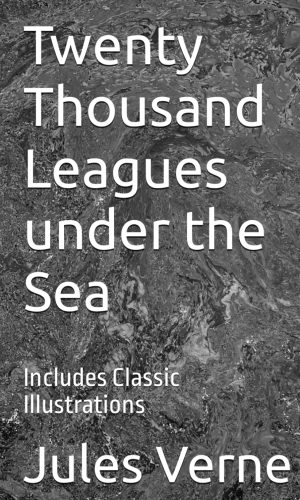Twenty Thousand Leagues Under the Sea (Wordsworth Classics)
£3.20
With an exclusive introduction and notes by David Stuart Davies.
Translation by Louis Mercier.
Jules Verne’s 20,000 Leagues Under The Sea is not only a classic science fiction novel, it is also a thrilling adventure yarn.
Professor Aronnax, his faithful servant Conseil and Canadian harpooner Ned Land are held prisoners aboard the fantastic submarine, the Nautilus, by its enigmatic and charismatic commander, Captain Nemo: ‘That terrible avenger, a perfect archangel of hatred.’
And so begins a hazardous and eventful voyage which leads them from the lost city of Atlantis, to the South Pole, hunting in underwater forests and to an encounter with a ferocious giant squid.
Published in 1870, the novel continues to fascinate and engage the reader, presenting as it does an incredible journey into a mysterious world of excitement and danger!
Read more
Additional information
| Publisher | Wordsworth Editions (5 May 1992) |
|---|---|
| Language | English |
| Paperback | 256 pages |
| ISBN-10 | 9781853260315 |
| ISBN-13 | 978-1853260315 |
| Reading age | 8 – 12 years |
| Dimensions | 12.65 x 1.4 x 19.79 cm |










by Elaine Sayle
I have just finished reading this book and I thought that although it was a very interesting book to read it was also a very factual and explanative book with regards to technical things with regard to the Nautilus and very explicit about the fish and fauna that live in our grand oceans around the world. A very informative and educational book. Very enjoyable to read and actually understand the meaning of 20,000 Leagues rather than the assumption it was the depth of the ocean travelled but actually the distance travelled which makes more sense since our oceans are no way that deep!!. A book that should be on any persons lifetime list of books to read. A good classic that has lasted well. A book for any avid or novice reader of any age.
by Kevin Crowe
I regularly return to classic books from my youth, sometimes disappointed, but often enjoying them as much as I once did, sometimes even more given the greater understanding that age brings. I have recently been rereading some of Jules Verne’s classic 19th century science fiction books, and one in particular has surprised me by how modern it is in parts, though other parts are inevitably dated. “20,000 Leagues Under the Sea” (originally serialised in France 1868-70) is a great adventure story about three people who are rescued by the captain (Nemo) of the submarine Nautilus, but then discover they won’t be allowed to leave the ship as it travels through all the world’s oceans. But it is more than an adventure story: Verne also foresaw the development of submarines that could spend long periods under water, as well as effective diving suits. Some of his other “science” is less reliable (in the novel the Antarctic is an ocean, not a continent, for example). But even more than that, Verne expressed concerns about political and social issues that are very much 21st century concerns.
Two such issues feature strongly. One is concern for the environment: in various passages both Nemo and the captive scientist and narrator Professor Pierre Aronnax express concern about what humanity is doing to the planet, referring to the disappearance of various species of whales and other creatures that, in their view, could lead to the oceans becoming deserts. The other major issue raised on several occasions by Nemo is the west’s exploitation of Africa and Asia and its treatment of native populations. Nemo declares himself to be on the side of the oppressed and in one passage collects gold ingots from a shipwreck which he passes on to rebels fighting for freedom. Such foresight and awareness was at the time rare among western writers.
Although we don’t know Nemo’s full history, we do know he has rejected the world because of a devastating tragedy.
Finally, the name Nemo itself is interesting. Nemo is Latin for nobody and as a name has a long literary heritage, with two previous uses particularly interesting. In Homer’s epic poem “The Odyssey”, Odysseus at one point refers to himself as Outis – Ancient Greek for nobody – in order to hide his real identity. Thousands of years later in his novel “Bleak House”, Charles Dickens introduces a character called Nemo. Although Nemo dies of an opium overdose early in the novel, his past plays a crucial part in the novel’s plot development, a novel in which nothing is as it seems. Jules Verne would have been well aware of the use of the name by both Homer and Dickens.
I’ve thoroughly enjoyed rereading “20,000 Leagues Under the Sea” after all these years, particularly discovering much that I missed first time round in my early teens.
by scooter
About 75% of the narrative is describing all the fish and plants seen from the window!
by irishpropheticart
I wanted to read a book by Verne’s,so I did.Very good writer and had a very good vision of things to come.The submarine and its basic mech. was spot on!
The book bogs down in that Verne’s was overly descriptive page after page of fish,marine life-some he just totally made up(it is fiction I understand).It was like Verne’s had a marine book at his hand and he tried to fill the pages with all the different variety of life under the sea.Maybe that was his point. He may have been trying to build his audience interest in the sea and its life?
by A9000
I love early science fiction and have read so much H.G. Wells that I thought I should give this a try.
The story itself is actually pretty good. I really felt that the settings felt a little futuristic even all this time later, although possibly a little steam-punkish because the primary power of the day was of course iron and steam!
Verne wanders into too much description of the classifications of fish and the characters do seem to catch and eat every living thing they come across. Those parts were a little dull, but the main story is really quite gripping with some fantastic ‘how will they get out alive?’ moments!
I haven’t quite finished the book because I am a lazy reader, but for this price the entertainment value is unbeatable.
by Nerdish Mum
Actual rating 4.5 stars.
I completely and utterly fell in love with this book. To me this is exactly what an adventure book should be like. There are pirates and mystery and hidden caves.
I have to disagree with the synopsis stating that Captain Nemo is one of the most horrible villains as I have to say I really related to him and I’m certainly not a villain! Yes he has killed people, usually only when they are attacking him and his ship. To be able to go so completely off the grid and survive off the land, or in this case the sea and to find hidden wonders that no one else has ever seen sounds absolutely wonderful! To be so intelligent and continue your learning indefinitely within your own personal library, I’d imagine that quite a few people would enjoy this.
Professor Aronnax and his personal servant Conseil have an extremely strong bond and have a mutual respect that is good to see. Ned Land though to me is another far more interesting character as he is a rugged adventurer from Canada who has seen the world and needs to be out there to really live. He struggles with captivity and suffers from cabin fever which you can feel through the excellent writing.
There is a lot of scientific, nautical and geographical language used throughout the book and a lot of classification of sea life is done, but this did not take away any enjoyment for me as I enjoyed searching online what things meant when I didn’t understand and learning, I enjoyed the learning.
Hopefully I will have time in the future to come back and re read Twenty Thousand Leagues Under The Sea so I can revisit Captain Nemo and enter his exciting underwater world.